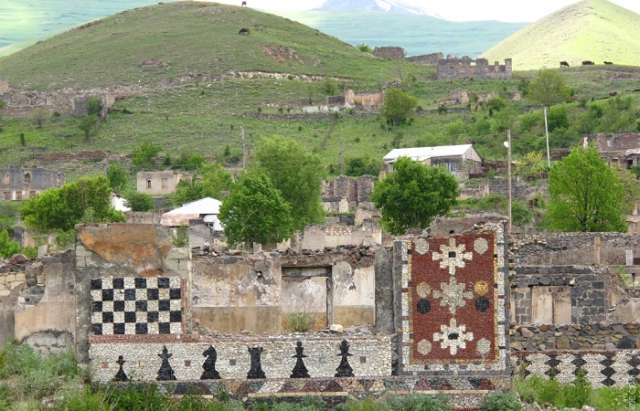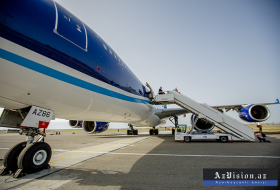Aggression by Republic of Armenia

* the territory of the Nagorno-Karabakh region (former Nagorno-Karabakh Autonomous Oblast (NKAO), abolished in 1991);
* the territories of 7 regions bordering with Nagorny Karabakh (Aghdam, Fizuli, Djabrail, Zangelan, Gubadly, Lachin and Kelbajar);
* the territories of 4 regions bordering with Armenia (Gazakh, Agstafa, Tovuz and Gedabey);
* the territories of 4 regions bordering with the Line of Contact (Ter-Ter, Goranboy, Agdjabedi and Beylagan);
* the territories of the administrative regions of the Nakhichevan Autonomous Republic (Azerbaijani exclave, separated from the rest of the republic in 1920),
Total: 17,000 sq.km. (10,563 sq. miles)
Occupied regions of Azerbaijan has been totally destroyed and robed. The great economic damage has been inflicted also to 4 regions of Azerbaijan bordering with Armenia, 4 regions bordering with the Line of Contact and the territories of the administrative regions of the Nakhchivan Autonomous Republic.
From the beginning of the aggression against Azerbaijan, more than 877 settlements have been burned and destroyed.
"The actions taken by the government of Armenia in the context of the conflict over Nagorno-Karabakh are inconsistent with the territorial integrity and national sovereignty principles of the Helsinki Final Act. Armenia supports Nagorno-Karabakh separatists in Azerbaijan both militarily and financially. Nagorno-Karabakh forces, assisted by units of the Armenian armed forces, currently occupy the Nagorno-Karabakh region and surrounding areas in Azerbaijan. This violation and the restoration of peace between Armenia and Azerbaijan have been taken up by the OSCE."
Bill Clinton, President of the United States of America
(Source: Presidential Determination (PD) No. 99-8 of December 8, 1998, and PD No. 98-11 of January 26, 1998, Memorandum for the Secretary of State, Re: "Assistance Program for the New Independent States of the Former Soviet Union.")
In the late 18th century, several khanates [Azerbaijani states], including Karabakh [founded in 1747], emerged in the south Caucasus to challenge the waning influence of the [Iranian Empire and] Ottoman Empire. After the Russian Empire eventually took control over the region in 1813, Azerbaijani Turks began to emigrate from Karabakh while the Armenian population of mountainous (Nagorno) Karabakh grew. With the 1917 Russian Revolution, Azerbaijan and Armenia each declared independence [in 1918] and sought control over Karabakh during the Russian Civil War. In 1923, after the Bolshevik takeover of the Caucasus, Nagorno-Karabakh (NK) was made an autonomous region [NKAO] within the Azerbaijani Soviet Republic. Soviet control temporarily quieted ethnic tensions.
By the 1980s, NK`s population was about 75% ethnic Armenian, with most Azerbaijanis living in the district and city of Shusha. [According to the last official Soviet census (1989), 91.7% of population of Shusha district and 98% of the city Shusha were ethnic Azerbaijanis. Since 1992, all were either killed or became refugees (IDPs) It is important to note the spiritual, cultural and historical value of Shusha and Karabakh region to all Azerbaijanis. According to Encyclopedia Britannica: "The people of Azerbaijan have retained their ancient musical tradition. For example, the art of ashugs, who improvise songs to their own accompaniment on a stringed instrument called a kobuz, remains extremely popular. Mugams, vocal and instrumental compositions, are also widely known, the town of Shusha being particularly renowned for this art"].
The violence increased dramatically after the withdrawal of Soviet troops. Over 30,000 people were killed in the fighting from 1992 to 1994. In May 1992, Armenian and Karabakh forces seized Shusha (the historical, Azerbaijani-populated capital of the region) and Lachin (thereby linking NK to Armenia). By October 1993 Armenian and Karabakh forces eventually succeeded in occupying almost all of NK, Lachin and large areas in southwestern Azerbaijan. As Armenian and Karabakhi forces advanced, hundreds of thousands of Azerbaijani refugees fled to other parts of Azerbaijan. In 1993 the UN Security Council adopted resolutions calling for the cessation of hostilities, unimpeded access for international humanitarian relief efforts, and the eventual deployment of a peacekeeping force in the region. The UN also called for immediate withdrawal of all ethnic Armenian forces from the occupied territories of Azerbaijan. Fighting continued, however, until May 1994 when Russia brokered a cease-fire.
(Source: U.S. Department of State, History of the Nagorno-Karabakh Conflict, March 30, 2001. Abridged version with comments by ASA).
"At the end of 1991, the conflict between Armenia and Azerbaijan escalated into war. Between 1992 and 1994 almost 20 percent of the Azerbaijan`s territory, including six districts of Azerbaijan in addition to Nagorno-Karabakh, were under Armenian control, resulting in mass population displacement within the country. The State estimated the number of internally displaced persons at 778,500 by the end of 1993, and 604,574 as of 1 March 1998. UNHCR estimates are lower, with 551,000 persons at the end of 1997." (International Organization for Migration, 1999, Migration in the CIS 1997-1998, 1999 Edition, p. 40)
"More than 568,000 persons from western regions of Azerbaijan under Armenian occupation since 1993, including 42,072 from Nagorno-Karabakh, remained displaced within the country. Most were displaced from regions just outside Nagorno-Karabakh, including Fizuli (133,725 persons), Agdam (128,584 persons), Lachin (63,007 persons), Kalbajar (59,274), Jabrayil (58,834 persons), Gubadli (31, 276), Zangilan (34,797), Terter (5,171) and Agjabedi (3,358)." (U.S. Committee for Refugees (USCR), 31 December 2000, World Refugee Survey 2000, Washington D.C.: Country Report Azerbaijan)
"The more than 600,000 displaced Azerbaijanis constitute the largest group of IDPs in the Caucasus. The displaced include the entire Azeri population of Nagorno-Karabakh and a wide area surrounding it. They comprise a broad range of professionals, farmers, and workers and include men, women, and children of all ages. Because of the ethnic basis of displacement in Azerbaijan, the IDPs there are virtually all Azeri (Turkic) peoples. Most of them are nominally Shia Muslim, but many of those from Lachin and Kelbajar Provinces are Sunni Muslim Kurds." (Greene, Thomas, 1998, The Forsaken People, "Internal Displacement in the North Caucasus, Azerbaijan, Armenia and Georgia" (Washington D.C: The Brookings Institution, p. 254)
"The overwhelming majority, over 99 per cent, of the internally displaced population are ethnic Azeris. The remainder are some 4,000 Kurds from the Lachin and Kelbajar districts and several hundred persons of various other ethnic groups, mostly Russian." (United Nations Commission on Human Rights (CHR), 25 January 1999, Report of the Representative of the Secretary-General, Mr. Francis M. Deng, Profiles in displacement: Azerbaijan (E/CN.4/1999/79/Add.1), para. 31)
"Now the longest-running conflict in the former Soviet Union, the battle for Nagorno-Karabakh has rapidly expanded and intensified since it began in 1988, resulting in the deaths of an estimated 25,000 soldiers and civilians and the displacement of one million others. What began with demonstrations calling for the unification of the Republic of Armenia with Nagorno-Karabakh, a largely Armenian [populated] region of Azerbaijan, became a full-scale war in 1992. In 1993, the war spilled into other parts of Azerbaijan as Karabakh Armenian forces, often with the support of the Republic of Armenia, conducted massive offensive military operations into the Azeri-populated provinces surrounding Nagorno-Karabakh." (Source: Human Rights Watch / Helsinki (HRW). Seven Years of Conflict in Nagorno-Karabakh, December 1994)
``An appropriate analogy with the Jewish Holocaust might be the systematic extermination of the entire Muslim population of the independent republic of Armenia which consisted of at least 30-40 percent of the population of that republic. The memoirs of an Armenian army officer who participated in and eye-witnessed these atrocities was published in the U.S. in 1926 with the title `Men Are Like That.` Other references abound.`` Rachel A. Bortnick - The Jewish Times - June 21, 1990.
After the war, relations between Armenia and Azerbaijan remained very tense. In 2008, Azerbaijani president Ilham Aliyev declared that “Nagorno Karabakh will never be independent; the position is backed by international mediators as well; Armenia has to accept the reality” and that “in 1918, Yerevan was granted to the Armenians. It was a great mistake. The khanate of Iravan was the Azeri territory, the Armenians were guests here."
The two countries are still technically at war and the Azerbaijani government regularly threatens to retake Nagorno-Karabakh by military force, if mediation of the OSCE Minsk Group does not succeed.
Citizens of the Republic of Armenia, as well as citizens of any other country who are of Armenian descent, are forbidden entry to the Republic of Azerbaijan. If a person`s passport shows any evidence of travel to Nagorno-Karabakh, barring a diplomatic passport, they are forbidden entry to the Republic of Azerbaijan.
In 2008, in what became known as the 2008 Mardakert Skirmishes, Armenia and Azerbaijan clashed over Nagorno-Karabakh. The fighting between the two sides was brief, with few casualties on either side.
June 2010 saw a brief flare up of the conflict, resulting in the deaths of four Armenian soldiers and one Azeri soldier. The clash came a day after peace talks between the Presidents of Armenia and Azerbaijan which were held in Moscow.
The Forgotten Victims of the Nagorno Karabakh Conflict
As sad and overwhelming as they may be, some experiences make you say, “I am glad I was there to witness it.” Meeting with the refugees and IDPs affected by the Nagorno Karabakh conflict was that kind of an experience for me.
The conflict started in 1989, when the Nagorno Karabakh Autonomous Oblast, a predominantly Armenian territory within Soviet Azerbaijan, declared its independence from Azerbaijan and union with Armenia. The resulting tension between the Armenian and Azerbaijani residents of NK soon turned into an ethnic conflict that led to the death of many and the displacement of many more. As the Azeris in Armenia, NK, and surrounding territories fled to Azerbaijan, the Armenians in Azerbaijan moved to NK and Armenia proper. The total number of displaced people is estimated to be one million.
Nineteen years after the ceasefire in 1994, an agreement between Armenia and Azerbaijan is still not reached and the NK Republic continues its existence as a de facto independent republic recognized by no other state. In the meantime, the life of a displaced person has become a permanent tragedy for the Armenian refugees as well as the Azeri IDPs.
The IDPs in Azerbaijan have more or less sufficient support from the government. As a sign of the national will to end the conflict and reclaim the territories, the IDPs from Shusha (a city inside NK with Azerbaijani majority prior to the war) have organized as a community in an area outside Baku, with their neighborhoods, schools, and arts centers. Although they have acceptable living standards, the government’s promise to return them to their homes perpetuates their status as IDPs and prevents them from integrating into the society. It also makes them put up with the misery of a temporary life in the expectation of a mutually-agreed settlement that does not appear to be in sight.
The situation of Armenian refugees is more dire. Having left Azerbaijan, the ones that chose to stay in Armenia faced two difficult choices. The first was to obtain Armenian citizenship and renounce all claims to assistance they might get through refugee status. The second was to remain as refugees but endure the costs of quasi-absent state support, insufficient mobility, and limited access to employment opportunities. Even in the Armenian capital, Yerevan, they live in abandoned buildings that raise sanitary concerns and accommodate far too many people. In addition to this, they lack the glimpse of hope that the Azeri IDPs have: they do not want to go back to Azerbaijan even if an agreement is reached because they are too afraid.
Although there is a vast difference between their living conditions, there is one thing that the Armenian refugees and Azeri IDPs have in common: despite experiencing the most suffering, they are the forgotten victims of this conflict. And as long as both governments define their national identities on the basis of this conflict and fail to reach an agreement, they will continue to be so.
Ezgisu Biber is a Master`s student at Johns Hopkins SAIS. She visited Azerbaijan and Armenia as part of a conflict management field trip.













































